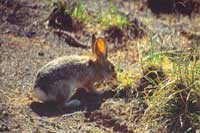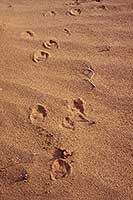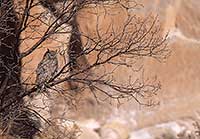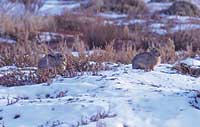Drive down one of the dusty Canyon Country roads at night and you will probably encounter several of the area’s nighttime creatures: jackrabbits and cottontails. Whereas the cottontails bolt across the road in an explosive sprint, jackrabbits often juke their way down the road like a wide receiver trying to outmaneuver a cornerback. That’s football-speak for the rest of you.
 The jackrabbits dizzying pace and attempts to shake your vehicle often results in the same question: why don’t they just run away from the road? Good question for which the jacks aren’t saying.
The jackrabbits dizzying pace and attempts to shake your vehicle often results in the same question: why don’t they just run away from the road? Good question for which the jacks aren’t saying.
Though both cottontails and jackrabbits are members of the Hare Family (Leporidae) and are considered lagomorphs, they are as different as deer are from elk.
Named for their fluffy-white, cotton ball tails, the desert cottontail is the smaller of the two species. Light colored fur that is tan to gray but with a slight yellowish tinge, orangish-brown throat, large ears and large hind feet identify Sylvilagus audubonii. Though desert dwellers, these cottontails tolerate the high temperatures by being active in the cooler hours of the day or night, and by shading up during the day. Their large ears have blood vessels near the surface which allows the rabbits to dissipate body heat to the air. 
Often hidden beneath a large shrub or tree, these rabbits attempt to elude prey by sprinting away from danger. Unfortunately many fall prey to eagles, hawks, coyotes, bobcats and other predators. Their high reproductive rate keeps the population intact. The Ancestral Puebloans used to snare or net rabbits for food; rabbit hair blankets have been found in some Southwestern archaeological sites. Even today, rabbits are still hunted for food.
Female rabbits become sexually mature around four months old and may raise 3-5 litters per year. Two to seven young are born in a shallow, fur- or grass-lined depression or burrow beneath a shrub. The young take a couple of weeks to develop, unlike jackrabbit young that are born eyes open and are ready to leave the ground nest soon after birth.
 Jackrabbits are larger than cottontails, have longer ears and hind feet, and have a black tail. In Utah both the black-tailed and white-tailed jackrabbit exists, but the black-tails are the common hare of southeastern Utah.
Jackrabbits are larger than cottontails, have longer ears and hind feet, and have a black tail. In Utah both the black-tailed and white-tailed jackrabbit exists, but the black-tails are the common hare of southeastern Utah.
Like cottontails, jackrabbits seek protection from shrubs and trees, eat a variety of grasses and forbs in the summer, and use explosive runs to avoid predators. Sprinting at 35 mph or leaping 20 feet doesn’t mean they always escape predators. However, a seven pound jackrabbit or four pound cottontail isn’t going to give up without a fight; both use their powerful hind legs to kick and swat at a predator.
 Jackrabbits have 3-4 litters per year and average 3-4 young per litter. In areas with few predators, the jackrabbit populations can soar.
Jackrabbits have 3-4 litters per year and average 3-4 young per litter. In areas with few predators, the jackrabbit populations can soar.
Similar to other members of their family, rabbits and hares produce two different types of feces. One is a soft pellet that is consumed and from which additional nutrients and vitamins are obtained. The other, harder pellet is the remains. Known as coprophagy, the process extracts valuable resources during this second passage through the system.
So keeps an eye out for these interesting desert dwellers during your visit to Canyon Country; both cottontails and jackrabbits form an important prey base that supports many predators in the region.

 The jackrabbits dizzying pace and attempts to shake your vehicle often results in the same question: why don’t they just run away from the road? Good question for which the jacks aren’t saying.
The jackrabbits dizzying pace and attempts to shake your vehicle often results in the same question: why don’t they just run away from the road? Good question for which the jacks aren’t saying.
 Jackrabbits are larger than cottontails, have longer ears and hind feet, and have a black tail. In Utah both the black-tailed and white-tailed jackrabbit exists, but the black-tails are the common hare of southeastern Utah.
Jackrabbits are larger than cottontails, have longer ears and hind feet, and have a black tail. In Utah both the black-tailed and white-tailed jackrabbit exists, but the black-tails are the common hare of southeastern Utah.  Jackrabbits have 3-4 litters per year and average 3-4 young per litter. In areas with few predators, the jackrabbit populations can soar.
Jackrabbits have 3-4 litters per year and average 3-4 young per litter. In areas with few predators, the jackrabbit populations can soar.